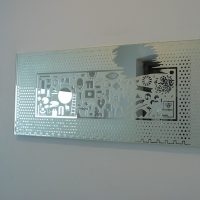A utopian approach to design first appeared in the modernist movements, questioning the ornamental function of design and lining it up for social and political goals. The sixties and seventies saw the appearance of anti-design; as a means of expressing a critical attitude, more and more artists turned to deliberately amateur DIY solutions.
Today, the design elements that were created originally out of political and social commitment have become freely interchangeable stylistic elements, devices of marketing, making the political decoding and conscious use of the diverse visual languages necessary for the critical approach.
The exhibition presents the historical and contemporary projects and publications from the boundary of design and the visual arts in three groups: Typographical utopias, Parallel design, Subversive design.
Anti- and parallel design
The degree zero of typography, handwriting, or typewritten, photocopied, stapled publications are not always shortcomings but the "trademarks" of political, cultural and market resistance. Eastern-European neo-avant-garde artists and samizdat publishers often use such solutions as a revolt against the "good taste" and professionalism representative of institutions. This segment focuses on Eastern-European artists’ publications, historical and contemporary practices applying deliberately rudimentary and unpretentious design techniques.

